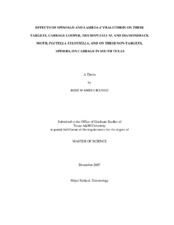| dc.description.abstract | A randomized block experiment was conducted in cabbage fields at Texas
Agriculture Experiment Station at Weslaco in the spring and fall 2005 and spring 2006.
There were four blocks and two pesticide treatments, spinosad (SpinTor®), lambda-
cyhalothrin (Warrior®), and an untreated control. The pesticide treatments were for the
management of Plutella xylostella L. (Lepidoptera: Plutellidae) and Trichoplusia ni
(Hubner) (Lepidoptera: Noctuidae).
Pitfall traps captured eight families of spiders in fall 2005, and thirteen families
in spring 2006. The most abundant family was Lycosidae with Pardosa delicatula
(Gertsch and Wallace) followed by Pardosa pauxilla (Montgomery) and Hogna helluo
(Walckenaer) in fall 2005, while in spring 2006 Hogna helluo was most abundant
followed by Pardosa delicatula and Pardosa pauxilla.
The diversity of spiders in fall 2006 in the lambda-cyhalothrin plots was lower than that
of spiders found in the untreated control or the spinosad treated plots, which were up to 2.6 and 2.4 times, respectively, more diverse. In spring 2006, the spiders in untreated
control and spinosad treated plots were 1.5 and 1.3 times respectively more diverse than
spiders in the lambda-cyhalothrin treated plots. In fall 2005, mean diversity of spiders in
spinosad treated plots was 1.1 times more diverse than in the untreated control, although
this difference was not statistically significant. In spring 2006, spinosad treated plots had
1.2 times greater diversity than untreated control and this difference was significant.
The effects of two insecticide treatments on height, width, and weight of
cabbages were highly significant in all three seasons. Cabbage harvest in spinosad and lambda-
cyhalothrin plots showed greater height, width, and weight than in untreated control but
were not different from each other. However, in the larval damage rating, spinosad
treatment showed better management of diamondback moth and cabbage looper than lambda-
cyhalothrin. | en |
| dc.title | Effects of spinosad and lambda-cyhalothrin on their targets, cabbage looper, Trichoplusia ni, and diamondback moth, Plutella xylostella, and on their non-targets, spiders, on cabbage in south Texas | en |


